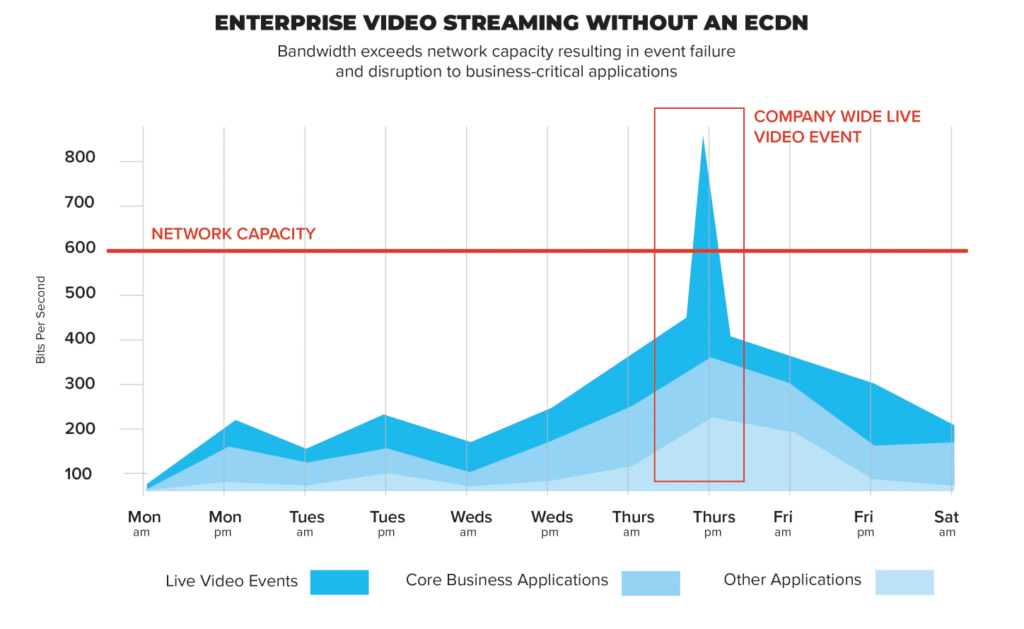With large numbers of employees still working from home, many enterprises are adopting a video-based culture to aid in corporate communications. What is often missed however is the impact live video can have on your network. This is where network capacity planning comes in.
Network capacity planning helps network administrators understand a network’s shortcomings. Typically, it involves gathering data around:
- Network traffic
- Traffic type
- Utilization rate
- Infrastructure capacity
The purpose of network capacity planning in regard to video is to find out if your network can handle the demand for live and on-demand streaming.
In the last few months, we’ve heard a few justifications for why some organizations have avoided network capacity planning prior to running live events.
“We have plenty of bandwidth. We don’t even have half of our employees back in the office yet.”
“Video will be easy. We’re running a skeleton crew.”
Unfortunately, those arguments don’t hold up in the new normal. Here’s a real-world example from a Kollective customer that explains why.
10% of Employees Can Consume 70% of Network Capacity
A leading agricultural organization recently broadcast a virtual Town Hall Meeting to its globally distributed workforce of 45,000 using a top webcasting platform. Their corporate headquarters, normally alive with more than 5,000 employees, had less than 10% of its staff in office on the day of the event.
With so few employees onsite at HQ, the IT team was confident they could live stream the Town Hall without activating an enterprise content delivery network (ECDN) to optimize bandwidth consumption.
The result? Seventy percent of HQ’s total network capacity was consumed by less than 10% of the workforce.
Given the physical distancing measures required in the workplace, each of those 500 employees participated in the Town Hall from their own computer, pulling the video stream directly from the source instead of gathering to watch in the HQ auditorium. This put immense strain on the network.
If you do the math, that means their network would not be able to support even 15% of employees streaming video from HQ.
What happens when the bulk of employees return to the office?
The Weight of Synchronous Video
The goal for every organization shifting to a video-based culture is to deliver a high-quality viewing experience that is inclusive to all employees, regardless of location, bandwidth or device. Although our customer may have network capacity at Corporate HQ, they also need to address remote office and branch locations that are the most likely to struggle with scaling live and on-demand video.
For context, live events created in Microsoft Stream get a fixed encoding profile:
- 720p - 3.5 mbps
- 540p - 2.2 mbps
- 396p - 1.4 mbps
- 288p - 850 kbps
- 216p - 550 kbps
- 192p - 200 kbps
What’s important to note is that video playback is not a static number and will change according to:
- The video’s original resolution, bitrate and content
- A user's available bandwidth
- Size of the player
You can estimate the impact video will have on your network by measuring and sampling the bandwidth of the content typically produced by your organization. Extrapolate that out across the total number of employees likely to view said content, and you can see how quickly the bandwidth required to stream video at scale adds up.
How an ECDN Optimizes Bandwidth Consumption
The simplest way to offset live video bandwidth consumption is with an ECDN. Kollective’s ECDN uses WebRTC technology to create a peering mesh between employees in a shared office location. Rather than everyone pulling content directly from the cloud and overwhelming your WAN (wide area network), a single peer gains access to the video and shares it with those nearby.
As you can see, a network without an ECDN is quickly overwhelmed by video – first by live playback and then by employees viewing the event on demand. This can have a dramatic impact not only on the viewing experience but also for business-critical applications that rely on the same network.

With an ECDN those network spikes are eliminated, which means you can be confident live video will not take down your network and the end user will have a high-quality viewing experience.

See How Peering Works
Take the work out of network capacity planning with Kollective’s ECDN. Try our demo today to see how we can help you deliver 100% of video broadcasts at 1% the bandwidth.
 Kunde
Kunde